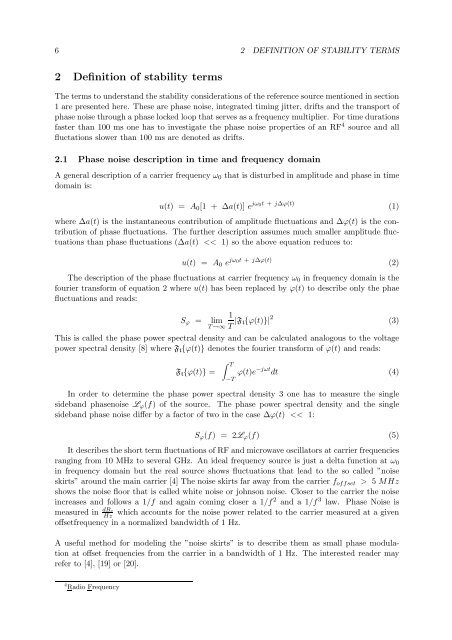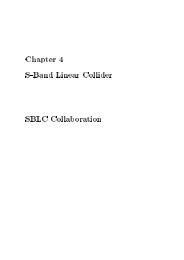Stability of the Master Oscillator for FLASH at DESY
Stability of the Master Oscillator for FLASH at DESY
Stability of the Master Oscillator for FLASH at DESY
Create successful ePaper yourself
Turn your PDF publications into a flip-book with our unique Google optimized e-Paper software.
6 2 DEFINITION OF STABILITY TERMS<br />
2 Definition <strong>of</strong> stability terms<br />
The terms to understand <strong>the</strong> stability consider<strong>at</strong>ions <strong>of</strong> <strong>the</strong> reference source mentioned in section<br />
1 are presented here. These are phase noise, integr<strong>at</strong>ed timing jitter, drifts and <strong>the</strong> transport <strong>of</strong><br />
phase noise through a phase locked loop th<strong>at</strong> serves as a frequency multiplier. For time dur<strong>at</strong>ions<br />
faster than 100 ms one has to investig<strong>at</strong>e <strong>the</strong> phase noise properties <strong>of</strong> an RF 4 source and all<br />
fluct<strong>at</strong>ions slower than 100 ms are denoted as drifts.<br />
2.1 Phase noise description in time and frequency domain<br />
A general description <strong>of</strong> a carrier frequency ω0 th<strong>at</strong> is disturbed in amplitude and phase in time<br />
domain is:<br />
u(t) = A0[1 + ∆a(t)] e jω0t + j∆ϕ(t)<br />
where ∆a(t) is <strong>the</strong> instantaneous contribution <strong>of</strong> amplitude fluctu<strong>at</strong>ions and ∆ϕ(t) is <strong>the</strong> contribution<br />
<strong>of</strong> phase fluctu<strong>at</strong>ions. The fur<strong>the</strong>r description assumes much smaller amplitude fluctu<strong>at</strong>ions<br />
than phase fluctu<strong>at</strong>ions (∆a(t)





